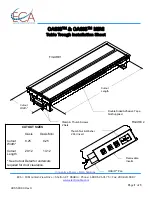
3Ć8
3.3
Cable System Protection and Isolation
Recommendations
Installation of the cable should conform to all applicable codes. To
reduce the possibility of noise interfering with the control system,
exercise care when installing cable from the system to external
devices.
3.3.1
Coaxial Cable Protection
Coaxial cable must be handled properly prior to and during
installation. Improper handling may result in cable damage and
require cable replacement. Use the following guidelines when
handling the coaxial cable:
Keep the cable ends tightly sealed (e.g., with cable caps) during
cable storage, transportation, and installation. Keeping the cable
ends sealed will prevent exposure to moisture and other foreign
matter.
Do not exceed the minimum bend radius of the cable during
storage or installation. Refer to Appendix F for cable
specifications. Bending the coaxial cable more sharply than the
recommended minimum bend radius may decrease the reliability
of the Remote I/O system.
Prevent the cable from contacting abrasive surfaces such as
concrete.
Follow the cable pulling recommendations given in section 3.4.2.
3.3.2
Electrical Isolation
Use the following guidelines when installing the coaxial cable to
ensure electrical isolation:
The exposed metal parts of the Remote I/O cable system
components (BNC connectors, adapters, terminating loads) must
not come in direct contact with electrical conductors (including
electrical enclosures, AutoMax and Shark racks, Remote Head
chassis, tap shells, conduits, etc.). If necessary, these components
should be shielded using insulating jackets, heat shrink tubing, or
electrical tape.
The Remote I/O coaxial cable must be installed in a separate
metal conduit. This conduit must be properly grounded along the
entire length.
The Remote I/O coaxial cable must not be installed closer than
three feet away from electrical motors, generators, transformers,
arc welders, rectifiers, high voltage lines, induction heat sources,
and sources of microwave radiation.
If grouping the Remote I/O coaxial cable with other cables cannot
be avoided, you must follow the recommendations provided in
ANSI/IEEE Standard 518.
Grounding, lightning, and surge protection of the Remote I/O
cable system and attached equipment must comply with the
requirements of the National Electrical Code and applicable local
codes.
Содержание AutoMax 57C328
Страница 1: ......
Страница 7: ...VI Figure 5 1 Drop Status Monitoring 5 1 Figure 6 1 AutoMax Rail Fault LED Codes 6 5...
Страница 14: ...fafadfdfdasfdsfdsdsdfdsfdsfdsfsdfdsa afdfdsfdsfdfdsfdsfsadfda asfdfaddfdd...
Страница 16: ......
Страница 47: ...4 0 4 0 0 2 0 0 0 0 0 0 2 2 0 0 0 0 0 1 0 0 3 0 0 4 1 2 0 0 0 2 1 2 2 0 4 0 0 0 0 0...
Страница 70: ......
Страница 84: ...fafadfdfdasfdsfdsdsdfdsfdsfdsfsdfdsa afdfdsfdsfdfdsfdsfsadfda asfdfaddfdd...
Страница 97: ...Appendix B Block Diagrams Remote I O Communications Module M N 57C416 0 3...
Страница 99: ...Appendix B Remote I O Head M N 57C328 and M N 57C330...
Страница 100: ...Appendix B Remote Drive Interface Head M N 57C329...
Страница 102: ...fafadfdfdasfdsfdsdsdfdsfdsfdsfsdfdsa afdfdsfdsfdfdsfdsfsadfda asfdfaddfdd...
Страница 104: ...fafadfdfdasfdsfdsdsdfdsfdsfdsfsdfdsa afdfdsfdsfdfdsfdsfsadfda asfdfaddfdd...
Страница 105: ...Appendix E Schematics Communications Passive Tap M N 57C380...
Страница 106: ...Appendix E Continued Fiber Optic Rack Power Supply M N 57C368...
Страница 110: ...fafadfdfdasfdsfdsdsdfdsfdsfdsfsdfdsa afdfdsfdsfdfdsfdsfsadfda asfdfaddfdd...
Страница 114: ...fafadfdfdasfdsfdsdsdfdsfdsfdsfsdfdsa afdfdsfdsfdfdsfdsfsadfda asfdfaddfdd...
Страница 118: ...0 0 0 0 0 0 0 0 0 0 0 0 0 0 0 0 0 0 0 0 0 0 0 0 0 0 0 0 0 0 0 0...
Страница 142: ......
Страница 143: ...fafadfdfdasfdsfdsdsdfdsfdsfdsfsdfdsa afdfdsfdsfdfdsfdsfsadfda asfdfaddfdd...
















































